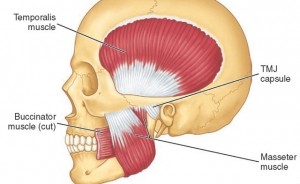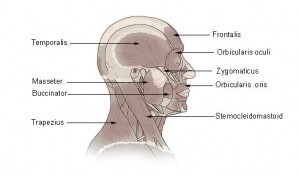The Strongest Muscle In The Body
The direct answer to the question about the strongest muscle in the body is the Masseter, one of the muscles of mastication, or chewing.
The masseter is a quadrilateral muscle with both deep and superficial insertions. Quadrate muscles are stabilizing muscles and tend to be very powerful.
But first, we need to define what we mean by the strongest muscle. Strength in general usually refers to the capacity for either resistance or exertion.
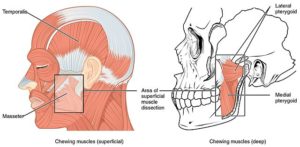
In the case of the masseter as the strongest muscle in the body, it is because it can generate the largest measurable force of any single muscle.
It is so strong for two main reasons.
- It is made up of densely packed muscle fibers.
- It has a very short-armed lever ( I have been meaning to write about levers within the body forever)
The masseter is the strongest and most superficial of the four muscles of mastication.
This powerful muscle elevates the mandible, raising the lower jaw, and connecting the upper and lower jaw to facilitate the mashing of food while we eat.
The masseter is one of the muscles of the TMJ (temporomandibular joint) and while it may be the strongest muscle in the body it is often the most stressed out as well.
If you are someone who grinds their teeth you have a very unhappy (as well as tight) masseter muscle.
There is also an emotional aspect to the masseter muscle that will be saved for another post.
TMJ dysfunction is highly common and stress is one of the factors that lead to these issues.
Emotional stress can cause the masseter muscle to tighten up.
As it remains tight, its hyper-engagement registers this stressful reaction to the brain and the nervous system which can get caught up in an endless cycle of stress that can be very difficult to break.
Finally, because I always have to mention the pelvis and psoas, the alignment of these two essential body parts can have a large impact on the masseter muscle.
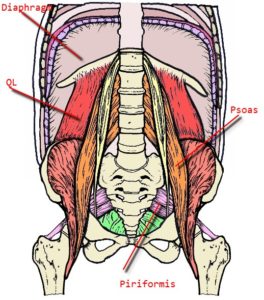
The Pelvis, Psoas, Piriformis, Gluteus Maximus & Posture
I consider the psoas to be the most important muscle in the body. Whenever I post that I get snarky comments about the heart and tongue.
While they are obviously important, the psoas determines so much of our physical and emotional well being
The alignment of the psoas is intimately related to the position of the pelvis and how the legs sit under the hips.
The femur bones should fall directly under the hips and your big butt muscle gluteus maximus shouldn’t sit down on the hamstring.
It should have a room of its own, so to speak, and that is one way to know that your pelvis is in a good neutral position.
The psoas attaches at six points. It connects to the back half of the inner thigh on a knob of bone called the lesser trochanter and it connects to all of the lumbar vertebrae.
The psoas is in a good position when the bottom of it, where it attaches to the back of the femur bone, is aligned with the back half of the body.
Unfortunately, I think most people sink or lean their thighs forward and this moves the psoas attachment at the inner thigh forward.
When well aligned, the psoas serves its role as an important postural muscle.
Positive tension is created by the fact that it attaches to the back of the lumbar spine and comes forward to cross the pelvis before moving back to attach to the back of the inner thigh.
At the back of the body two muscles, piriformis and gluteus maximus act with the psoas to create a good upright posture.
The psoas, piriformis, and gluteus maximus are the only three muscles attaching the legs to the pelvis and together they work to keep the spine upright.
These muscles working together successfully are the main thing that allows our body to work less when trying to hold itself up.
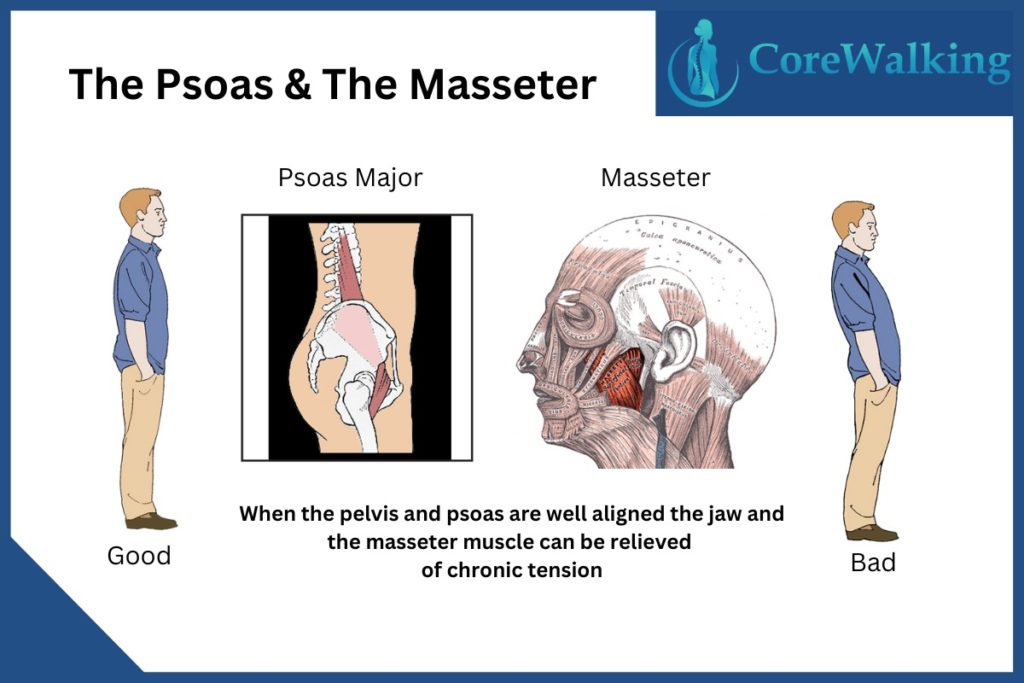
The Psoas & The Masseter
How does this relate to the strongest muscle in the body, the masseter?
While holding emotional tension in the masseter and that emotional tension is real, poor postural alignment of the pelvis and psoas causes physical tension as well.
The jaw is the top of the spine and any time the pelvis and psoas fall out of alignment the spine suffers and along with it, the jaw.
Ideal posture situates the head and rib cage directly above the pelvis and this would allow for the spine to be upright and the jaw to be relaxed.
If the pelvis is misaligned, the psoas with be misaligned and the alignment of the spine will suffer.
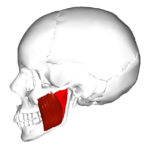 When the spine suffers so does the jaw and with it, the masseter.
When the spine suffers so does the jaw and with it, the masseter.
You can try to feel this by standing up in what you think is good posture and feeling your jaw and the masseter.
Then try to find better posture by taking your thighs back and relaxing your butt. A relaxed butt is a sure sign of better posture.
Try to feel a connection between a relaxed butt and a relaxed jaw. It is subtle but if you play around with it you will hopefully feel what I mean.
The masseter might be the strong muscle in the body but if it is misaligned you are compounding its misery but stacking tension upon tension.
Our bones hold us up and our muscles move us. When the bones are misaligned the muscles have to help to hold us up and no good can come of that.
Learn to align your pelvis and psoas and relieve at least some of the tension in the all-important masseter muscle.


